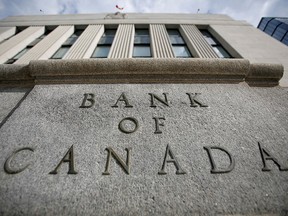Rising household debt and stress in the banking sector flagged as key risks to financial system
Article content
The rapid rise of interest rates have left the Bank of Canada more worried about Canadians’ household debt and cracks forming in the global financial system.
Advertisement 2
Article content
The strain of rising mortgage interest costs on indebted households and the aftershocks of the U.S. banking crisis have emerged as two key risks highlighted in the central bank’s latest Financial System Review.
Article content
The report says the central bank is “more concerned than it was last year” about households being able to keep up with debt payments.
“More households are expected to face financial pressure in the coming years as their mortgages are renewed,” the May 18 review read. “The decline in house prices has also reduced homeowner equity, and some signs of financial stress — particularly among recent homebuyers — are beginning to appear.”
In a press conference following the report’s release, senior deputy governor Carolyn Rogers said about one-third of households have already seen their mortgage payments increase since February 2022.
Article content
Advertisement 3
Article content
“Canadians have a long history of paying their debts even under stressed conditions,” Rogers said, adding that so far households have been resilient. “However, in a severe and prolonged recession, mortgage defaults could rise, leading to credit losses for lenders.”
Mortgage costs to keep rising
It warned that many more borrowers will see a significant bump-up in payments as they renew their mortgages, with costs rising by a median of 20 per cent between 2023 and 2026, assuming rates evolve along with current market expectations.
Variable-rate borrowers with fixed payments are expected to see the biggest spike with payments having to increase by up to 40 per cent to keep up with their original amortization schedule, assuming they renew in 2025 or 2026. Variable-rate mortgages with variable payments have already seen a near-50 per cent increase in payments, most of which took place last year.
Fixed-rate borrowers could see the biggest spike in their mortgage payments in 2025-26 with a 20 to 25 per cent hike, according to the central bank’s simulation.
Advertisement 4
Article content
Debt service ratios for new mortgages rose from 16 per cent to 19 per cent over the course of 2022. Homebuyers purchasing their homes at peak prices with smaller down payments are at a greater risk of having negative equity in their homes. This gives them less wiggle room to refinance and extend amortization periods to make it easier to keep up with monthly payments.
The more stretched households become, the more vulnerable they are to defaulting on their loans, especially if they’re hit with a large negative shock like a global recession that could leave them unemployed and with depressed home prices. Lenders could get stuck with sizeable credit losses, adding further strain to the financial system.
Signs of strain
Advertisement 5
Article content
So far, households have been able to manage the higher costs, though the central bank said there are pockets of strain appearing. There have been more households that are behind on payments for at least 60 days in any credit category.
Borrowers have also been stretching themselves to get into the housing market with lengthier amortization periods. The central bank noted the share of new mortgages with debt servicing periods longer than 25 years grew to 46 per cent from 41 per cent across 2022. This is also considerably higher than the 34 per cent share in 2019.
Higher mortgage interest costs were a big driver in the uptick in the consumer price index in April and they could complicate the Bank of Canada’s mission to tame inflation as they continue to rise in the months ahead.
Advertisement 6
Article content
Banking turmoil
A rising rate environment across the globe has also strained the banking system. The collapse of Silicon Valley Bank in March was followed by three other regional banks in the United States, and the emergency takeover of Swiss banking giant Credit Suisse.
“These events have exposed vulnerabilities — notably, business models that rely excessively on an environment of low interest rates and low volatility — and serve as a reminder that risks can emerge and spread quickly,” the report said.
As the financial sector adjusts to higher rates, central banks, market participants and regulators alike will need to be more vigilant, it stressed.
So far, the spillover into Canada’s banking sector has been subdued, partly because U.S. and Swiss regulators moved quickly to limit contagion, but also because of the sound risk management of Canadian banks and smaller exposure to the U.S. market, the bank said.
Advertisement 7
Article content
Canada’s regulations require banks to hold enough cash on hand to withstand an economic downturn or market crisis. A stress test included in the review found the banks’ capital positions would weaken, but not slip under the minimum requirements.
“Moreover, Canada rebuilt its domestic stability buffer after the onset of the COVID-19 pandemic,” the report read. “This means Canadian banks are holding additional capital buffers in case of a severe economic downturn.”
However, the central bank warned that if a severe recession hits, Canadian bank balance sheets would struggle with credit crunches and funding pressures.
-

What if interest rate hikes are doing more harm than good?
-

Surging mortgage interest costs are fuelling inflation
One credit risk the central bank’s report briefly flagged was banks with a higher exposure to commercial real estate, which has struggled after the rising popularity of working from home cut demand for office space.
“As a result, market valuations of firms in the office space subsector have decreased,” the report read. “If some of these commercial real estate firms were to default on their loans, lenders could face credit losses.”
• Email: shughes@postmedia.com | Twitter: StephHughes95
Bank of Canada flags household debt, banking stress as key risks
2023-05-18 15:34:48







Comments
Postmedia is committed to maintaining a lively but civil forum for discussion and encourage all readers to share their views on our articles. Comments may take up to an hour for moderation before appearing on the site. We ask you to keep your comments relevant and respectful. We have enabled email notifications—you will now receive an email if you receive a reply to your comment, there is an update to a comment thread you follow or if a user you follow comments. Visit our Community Guidelines for more information and details on how to adjust your email settings.
Join the Conversation